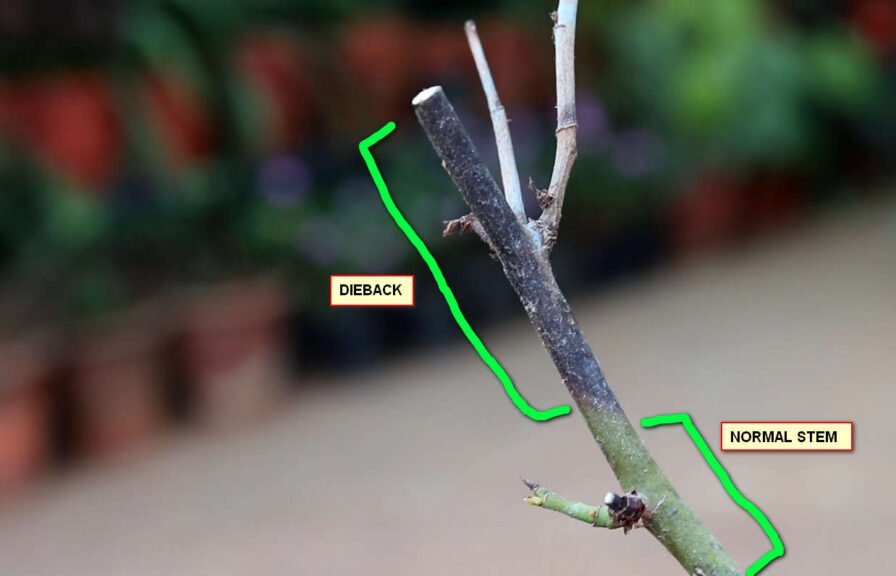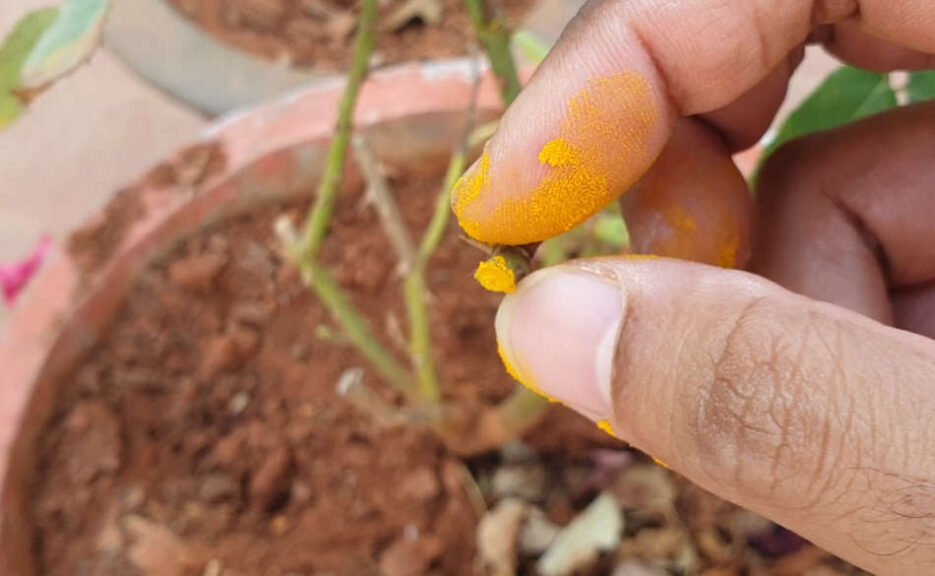Contents
In today’s article, we will look into What is Rose dieback disease, what are the causes of this rose plant dieback problem, and the best methods for prevention and treatment of rose dieback disease.

What is Rose Dieback Disease?
Rose dieback a.k.a Dieback of Rose, is a condition that affects rose plants, characterized by the browning or blackening of the tips of rose stems or branches. This dieback can spread down towards the graft and potentially engulf the entire plant, leading to its death if not addressed.
Several factors can contribute to rose dieback, including environmental stressors, fungal infections, pests, and improper pruning techniques.

One of the primary causes of rose dieback is fungal infections, such as Botrytis blight or canker diseases. These fungi can enter the plant through wounds or natural openings, causing the tissue to decay and die. Symptoms often include blackened stems, wilting leaves, and the presence of spore masses or lesions on the affected areas.
Pests, such as borers or aphids, can also contribute to dieback by feeding on the plant’s tissues or transmitting diseases. Regular monitoring and the use of appropriate pest control measures can help mitigate these threats.
Environmental factors, such as extreme temperatures, poor soil conditions, or inadequate watering, can stress the plant and make it more susceptible to dieback. Ensuring that roses are planted in well-draining soil, watered properly, and protected from harsh weather conditions can help maintain their health and resilience.
Improper pruning techniques, such as cutting too close to a bud eye or leaving stubs, can create entry points for pathogens and pests. Proper pruning, using clean and sharp tools, and making cuts at the correct angle just above an outward-facing bud can promote healthy growth and reduce the risk of dieback.
Types of Rose Dieback
Branch Dieback
Branch dieback affects individual branches of the rose plant. You’ll notice that specific branches start to wither and die off while the rest of the plant appears healthy. This type of dieback can often be caused by fungal infections, pests, or environmental stressors. Prompt pruning of the affected branches can help prevent the spread of the problem to healthier parts of the plant.
Main Stem Dieback

Main stem dieback targets the main stem, starting from the graft and moving upwards. This is more problematic than branch dieback because it affects the core structure of the plant. Common causes include improper pruning, physical damage, or disease. Addressing main stem dieback requires careful examination and potentially more drastic measures, such as cutting back to healthy wood or even replacing the plant if the damage is too extensive.
Rose dieback is a common problem faced by gardeners and can be severe if not managed promptly.
What Are the Causes of Rose Dieback?
Rose dieback can be caused by various factors that stress the plant, often leading to fungal infections that can spread throughout the plant. The key causes include:
Physical Injury
- Injury from Pruning: Poor pruning techniques, such as not cleaning pruning tools or cutting at incorrect angles, can lead to infections. Refer to my article on safe pruning techniques for detailed guidance.
Environmental Factors
- Overwatering and Underwatering: Both can contribute to dieback issues.
- Poor Soil Quality: Lack of proper nutrients can weaken the plant.
- Soil pH Problems: Roses thrive at a pH of around 6.5. Check out my previous episodes on soil pH for tips on checking and adjusting it.
Physiological Factors
- Natural Dieback: Sometimes, dieback occurs naturally on branches that have already flowered and are no longer producing new buds. This is a normal process to conserve energy for the rest of the plant.
Treatment of Rose Dieback Problem
Non-Chemical Methods and Preventive Steps
Soil Preparation
- Nutrient-Rich Soil: To combat rose dieback effectively, start with a strong foundation. Ensure your soil is well-balanced, incorporating both macro and micronutrients. This robust nutrient profile will strengthen your plants and help prevent infections. For those new to gardening or looking for guidance, there are many effective soil and potting mix recipes available online that can serve as a great starting point.
- Check Soil Drainage: Proper drainage is crucial in preventing waterlogging, which can lead to root rot and exacerbate dieback issues. If you’re using containers, make sure they have adequate drainage holes. Opt for well-draining soil mixtures, and steer clear of clayey soils, which retain too much moisture. To create an optimal potting mix, refer to comprehensive guides or watch instructional videos that detail universal potting mix recipes.
- Containers: Ensure proper drainage in pots to avoid waterlogging. Use well-draining soil mixtures and avoid clayey soils. For more details, refer to my video on Universal Potting Mix recipes.
Pruning

- Proper Techniques:
- Cleaning and disinfecting your pruning tools is essential to prevent the spread of disease among your plants. Use disinfectants like rubbing alcohol or hydrogen peroxide to thoroughly clean your tools both before and after each use.
- When pruning affected stems or branches, be meticulous. Cut at least an inch below the infected area, ensuring you include a portion of a healthy stem. This practice helps guarantee the complete removal of the infection, promoting the plant’s overall health.
- Finally, dispose of the cuttings properly. Make sure to remove them far away from other plants to prevent any potential spread of disease. By following these steps, you’ll keep your garden healthier and more vibrant.
Chemical Treatment
Applying Antifungal Treatments
Once you’ve completed pruning your plants, it’s crucial to apply an antifungal treatment to prevent infections. One effective option is a broad-spectrum antifungal powder like SAAF(Brand name), which combines Carbendazim and Mancozeb. This treatment helps protect the freshly cut ends from fungal attacks and ensures healthier regrowth.
Organic Alternatives

If you prefer a more natural approach, neem oil is an excellent alternative. Apply it directly to the cut ends of the pruned branches. Neem oil not only acts as an antifungal agent but also has antibacterial properties, offering comprehensive protection against a range of potential infections.
- Protect your oasis with Captain Jack’s Neem Max Concentrate; this multipurpose product acts as a 4-in-1 insecticide, fungicide, miticide and nematicide
- Captain Jack’s Neem Max Concentrate is approved for organic gardening; Cold Pressed Neem Oil is a plant based active ingredient that is effective in preventing and controlling diseases and pests in your garden
Home Remedies

In situations where you don’t have access to commercial antifungal treatments, common household items can be surprisingly effective. Turmeric powder, for instance, has natural antiseptic and antifungal properties. Simply dust the cut ends with turmeric to create a protective barrier against infections.
- PREMIUM USDA ORGANIC Turmeric POWDER (Curcumin Longa) – Our Gluten Free Organic Turmeric Root Powder is packed in a resealable kraft bag to maintain freshness!
- HIGH CURCUMIN CONTENT – Our Turmeric Powder is tested to have a minimum of 3% of Curcumin.
By taking these post-pruning care steps, you can significantly enhance the health and longevity of your plants. Whether you choose a chemical or organic treatment or even a simple home remedy, protecting your plants after pruning is essential for their continued growth and vitality.
Rose dieback and black spot rose disease are two most common problems affecting rose plants. Also please check out the Black spot rose disease problem article and How to Care for Rose bush and increase flowering.
Please Watch this video below on Rose Die-Back Disease and It’s treatment.
Last update on 2025-04-26 / Affiliate links / Images from Amazon Product Advertising API



1 comment
hello,
i am facing this stem die-back issue in my rose plant.
i tried all methods mentioned by you: used antiseptic solution to the pruning tool, pruned the dried stem along with natural stem at 45 degree, applied turmeric powder (as i didnt have anti-fungal powder /neem oil). but unfortunately the problem still persists.